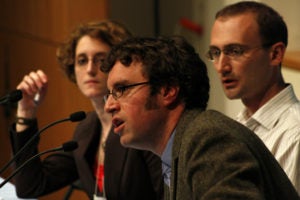April 18, 2009 | Citizen Journalism
The impact of web metrics on news judgment

How is citizen journalism understood? How does new technology help us understand our audience? These are questions Chris Anderson posed to the audience at the beginning of his panel during the 10th International Symposium on Online Journalism. Anderson looked at the relationship between a quantifiable audience (which can be measured in numbers, visits and clicks) and an active audience (a productive audience which at least rhetorically is creative/productive/engages in acts of production); a passive versus active producer of journalism.
The differences between these two audiences are not always distinct.
The rhetoric around these audiences are intertwined, and technology impacts editorial processes. “What I’m talking about in this study is how I saw in newsrooms the emergence of a certain type of metric–driven news judgment,” he said. Online data can be used by managers of newsrooms to make decisions, management deliberately putting out the numbers of traffic for people to see, and encourage news behavior in the newsroom.
“As aggregators, hierarchies, interlinkers and illustrators of web-content,” he said. These are people who are finding content, bundling it, packaging it, etc. He also said that the money for news media is dependent on metrics, and concluded by questioning the meaning of users who are producers of content.
ISOJ 2009: Looking Inward panel, from Knight Center on Vimeo.

